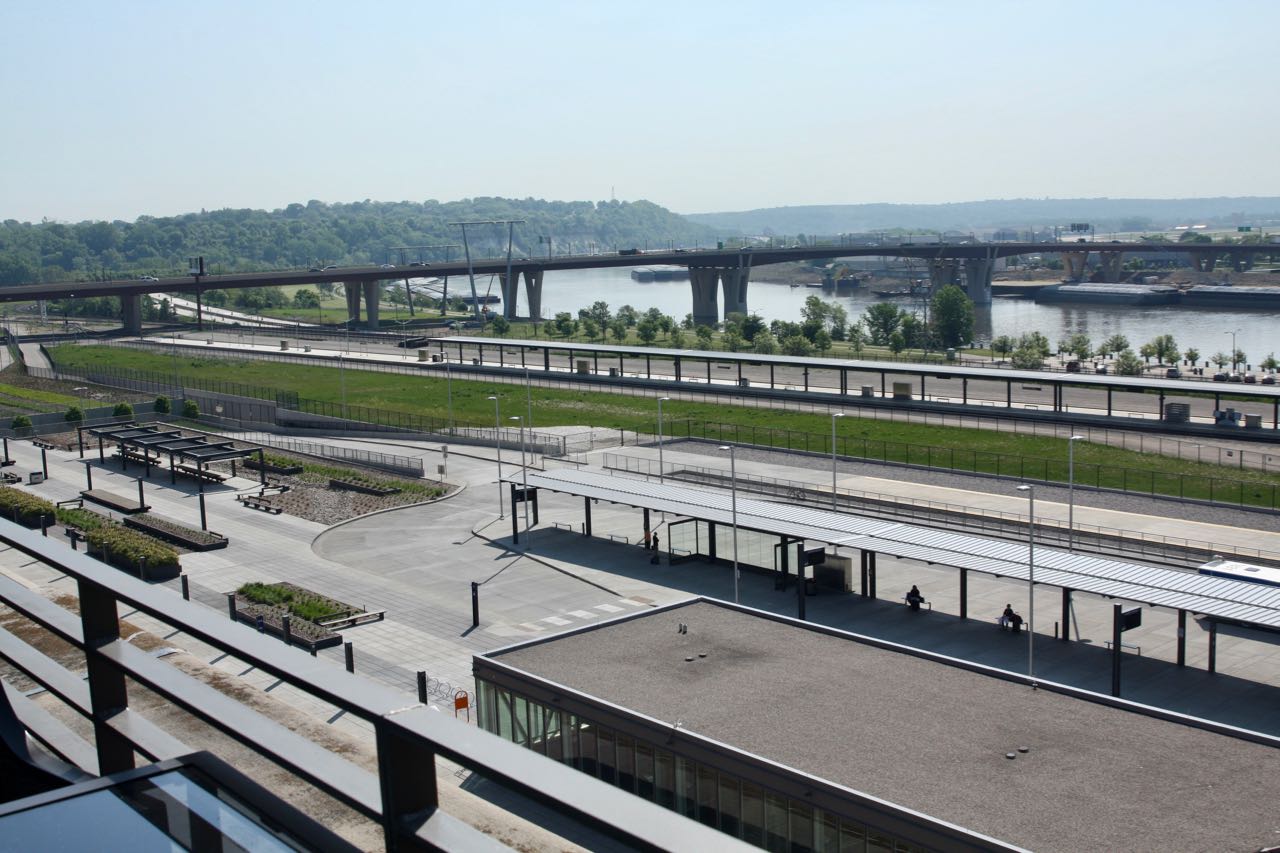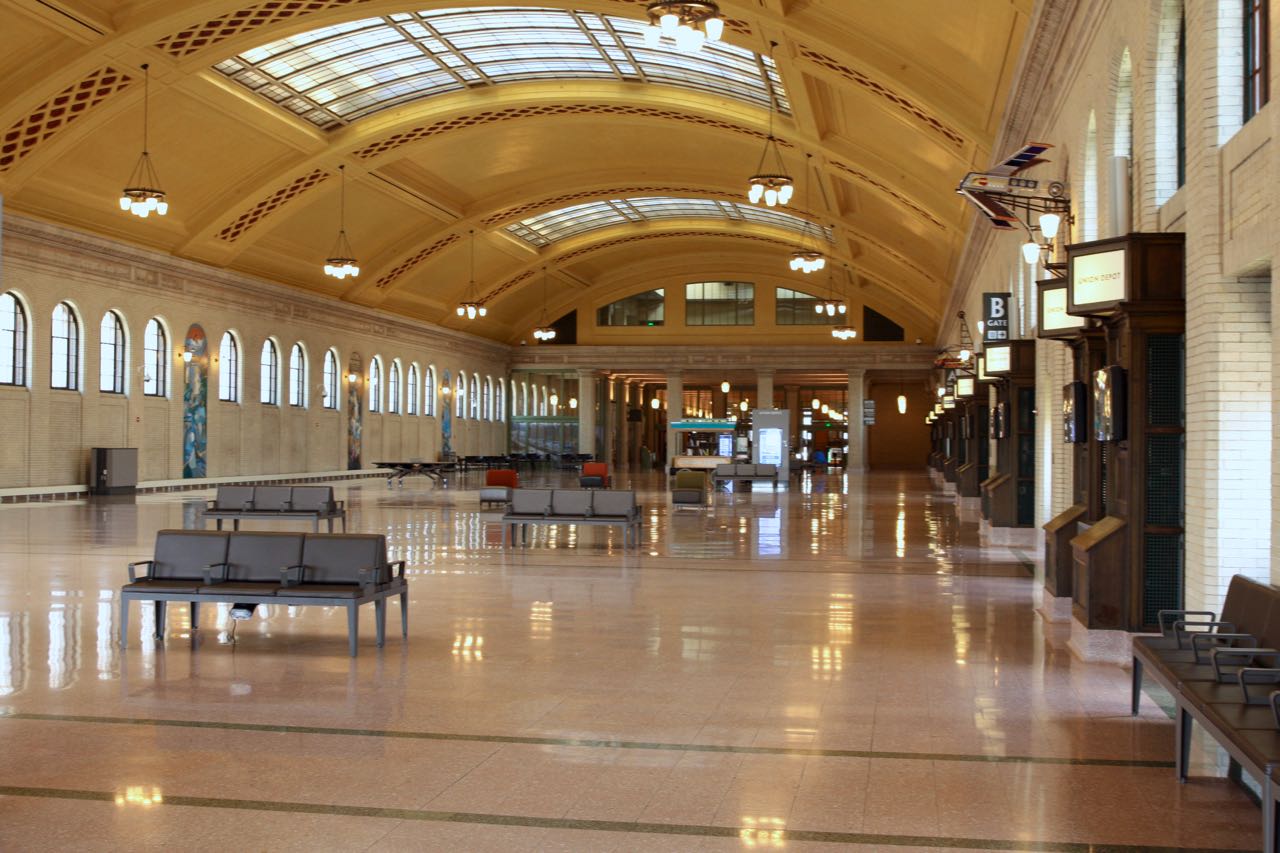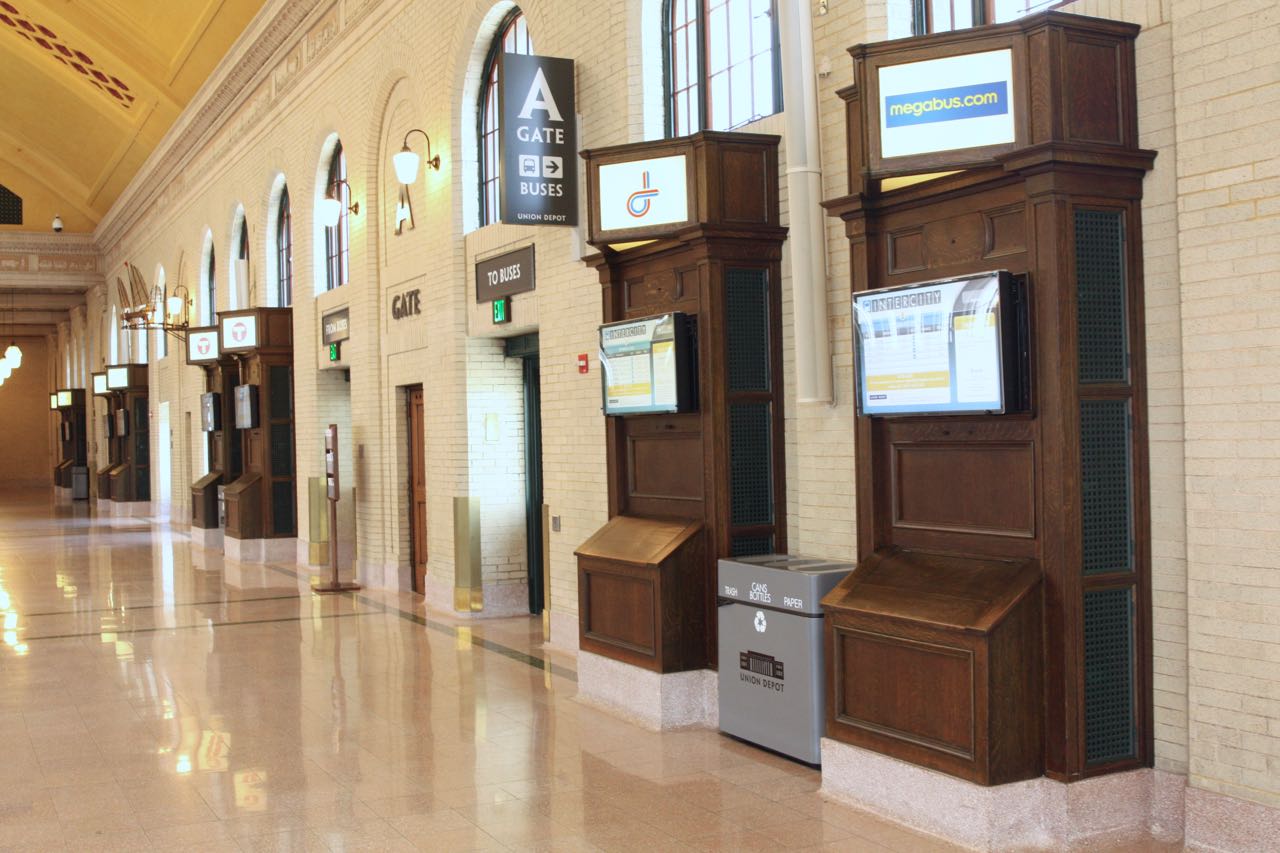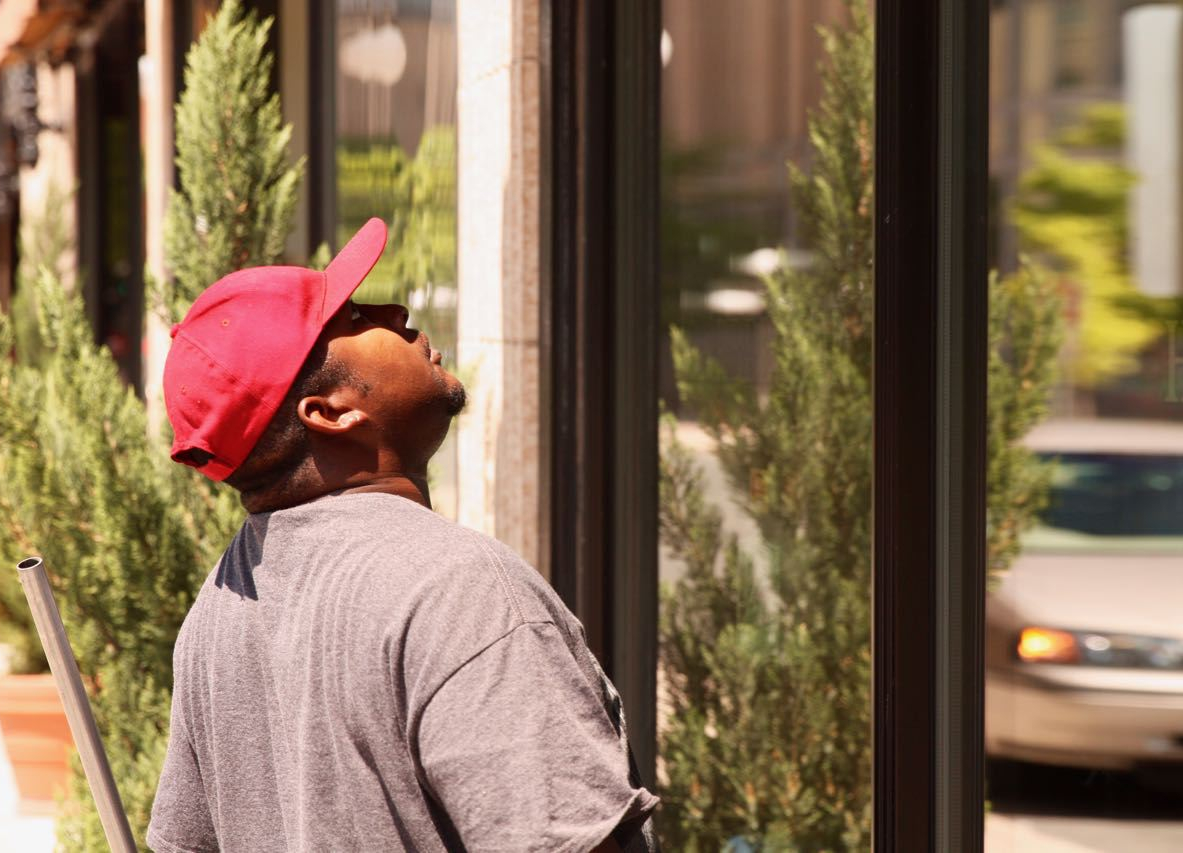
Saint Paul’s grand Union Depot viewed from 4th Street East and Wacouta Street.
May 21, 2016 Lowertown, Downtown 15 miles
The grand and solemn Saint Paul Union Depot is a train station. Although this seems patently obvious, Union Depot in fact took a 43 year break – from 1971 until 2014 – as the train station for Saint Paul.
Today, Saint Paul Union Depot is a transit hub, featuring two Amtrak trains a day, and dozens of local, regional and transcontinental buses, such as Metro Transit, Greyhound, Jefferson Lines, and Megabus.

Architect Charles Sumner Frost designed Saint Paul Union Depot in 1913 at the behest of James J. Hill. Construction began in 1917 but wasn’t finished until 1926 because of World War I. Courtesy Minnesota Historical Society.

Ten Tuscan columns grace the 4th Street main entrance of Union Depot.
Beyond transportation, the Saint Paul Union Depot is home to a coffee shop, a bike shop, and a few offices. It is also a gathering spot, with music, movies, yoga, private events, and family-friendly game playing. There is some beautiful art displayed, and a small but compelling museum about Union Depot itself.

Union Depot bustled with travelers during the 1920s through the ’40s as more than 200 trains served Saint Paul each day. James J. Hill brought nine local railroads together to form the company that built Union Depot. Photo courtesy UnionDepot.org
Workers spent more than 635,000 hours carefully restoring history and modernizing the station, according to the Saint Paul Union Depot Facebook page. The $243 million spent on the project included depot restoration, re-installation of railroad tracks and the purchase of property from the U.S. Postal Service and others.

Several steam engines await passengers in the Union Depot yard in 1925. Photo courtesy Minnesota Historical Society.

Passengers on one of the Union Depot platforms. There were 10 platforms and 21 tracks serving the depot. Photo courtesy Minnesota Historical Society.
Despite all that, the activity at the depot today is minuscule compared to during the heyday in the late 1920s. More than 20,000 passengers and about 275 trains moved in and out of Saint Paul Union Depot each day then. According to the book “St. Paul Union Depot” by John W. Diers, in 1927, the busiest year at the depot, an astonishing 490,000 tickets were issued. In 2015, a daily average of fewer than 700 passengers rode the two daily trains, the Green Line, and most of the buses.
One thing the depot has now but did not through most of its years is condominiums – 39 located above, along the perimeter of the main lobby, known as the head house. Ellen and Ken Green, friends of my next door neighbors, warmly opened their Union Depot condo to my curiosity, questions, and camera.

Ken and Ellen Green in the living room of their Union Depot condominium.
Ellen and Ken had been living in a condominium at Portland Avenue and Arundel Street in the Crocus Hill neighborhood for nearly 30 years before buying one of the depot condos. “We had been talking in general terms about selling, moving, going someplace else but hadn’t really thought of any particular place,” Ken said. “Ellen had mentioned Lowertown as a vibrant place and I didn’t know much about it.”
Ellen continued, “Originally I was interested in Lowertown because of working on a book with Weiming Lu. That’s where I really learned about some of the ins and outs and some of the things that they had done to really make this a vibrant area. It sounded really exciting to me. We’re both writers. We’re interested in art. The transportation was a big draw.”
Ken told me that he and Ellen toured the Union Depot condo on a lark. “We were down at the RiverCentre in 2014 and it was just before the Green line was to begin and just before the Amtrak was to return to the Union Depot, and Ellen said, ‘We’re pretty close. Why don’t we just go over to the Union Depot because they’ve done the renovation. Let’s take a look at it.’”
Once inside the depot, they noticed an Open House sign on the floor of the head house. Ken continued, “We were looking at it and all of a sudden this realtor showed up and he said, ‘You want to take a look?’ So we did. “
The realtor, who lived in one of the depot condos, spotted Ellen and Ken in the head house from his window. Ellen and Ken were both wowed by the condo. “When we saw this place we fell in love with it.” said Ellen.

The most unusual feature of the Green’s condo is location the windows, 20 or so feet above the main floor. Said Ellen, “It’s odd in that we can’t see out.”
And, added Ken, “There was actually no discussion. It was the most captivating idea. We were both grabbed by it.”
Ken said friends had a common reaction to their move. “We did tell people that we were moving into Union Depot and many people said, ‘I didn’t know they had condos there.’ One person said, ‘Oh, you’re homeless.’”
Just one friend expressed a dislike of their Union Depot home, Ken said. “One of my friends was in prison years ago. He’s the only person who hasn’t liked it because it reminded him of prison.”
Ellen and Ken loved visiting the Farmers Market, Mears Park and the Ordway Center before their move, so living in the depot means they’re just a short walk away. Then there was the train trip west aboard Amtrak’s “Empire Builder.” “We knew the train would leave from here, of course,” Ken said. “We did take that trip about two weeks after we moved in here. Simply walking down the stairs and getting on the train was magical.” Searching for words, he went on. “It was a wonderful idea and we were both captivated by it.”
Some unique situations come up when living in a building that was not originally designed to have residences within. For example, Ken mentioned deliveries. “I call Union Depot security and let them know. Then they give me access to the loading dock. They (the delivery truck and people) pull up to the loading dock, take all the stuff off, put it on dollies, go down this long hall, up one elevator to the waiting room level, come across the concourse, and then up elevator four to the second floor here. So it’s an involved route.”
That could be a moot point as Ellen added that she thinks they’re done with the furniture deliveries.

The condos’ second floor hallway is a bit narrow, creating a challenge for movers.
The condos offer direct access to the parking garage but the Greens don’t usually use it. “A lot of times we’ll go through the lobby to remind ourselves of where we are.”
Ellen delights in chatting with Depot employees and visitors. “We make friends with the security people. There are people who come into the Depot who don’t have anywhere to live. I talk to them. I’m an editor and that’s what I work with is stories and every single person has a story.”
After visiting for more than an hour, Ellen excused herself to meet a friend. Ken showed me the condo and then gave me a tour of parts of the depot.

The condo dwellers have a deck overlooking Lowertown and the Mississippi River.

The train and bus platforms at Union Depot, and the Mississippi River, as viewed from the rooftop deck, which is reserved for condo residents.

The mural “Forever Saint Paul” is made entirely with Lite Brites.

Close up of a section of “Forever Saint Paul.”

Looking at the head house from the concourse. The head house was placed on the National Historic Register in 1974.

The waiting area in which no one is waiting.

The stunning Union Depot concourse. The skylights were blacked out with tar in the early 1940s to make the Depot less susceptible to air attacks during World War II. The black tar was stripped away during renovations.

Another view of the skylights. The concourse, waiting room and train deck were added to the National Historic Register in 2014.

This is one of six murals by Ralph Gilbert inside the waiting room. It is about early times along the Mississippi River.

Called Interactive Multimedia Artwork Platform, or IMAP, the animated light system suspended from the ceiling is enthralling to watch. The two shadow figures run across the work.

Two people wait.

The view west out a waiting room window. The building on the right is the former post office. It was renovated and transformed into the Custom House Apartments and a Hyatt Place Hotel. The Wabasha Street Bridge is in the background.

The elegantly restored frescoes near the waiting room ceiling trace the history of transportation.

Looking through the 100 yard long waiting room toward the head house.

The Union Depot museum features displays, photos and artifacts of the building’s history.

This ticket punch is one the many preserved relics found during Union Depot renovations.

These ink bottles were uncovered during renovation.

Tools used in construction of the Depot more than 100 years ago.

When these were gates, stairways led from these doors to train platforms.

Bus lanes have replaced nearly all of the railroad tracks that ran to the depot. The structure with windows (left) takes passengers to and from the waiting room to the bus platforms.

In earlier days, the wood cases on the right were used to display the train schedules for the 21 passenger tracks that served Union Depot. Today, digital screens provide schedules for the bus lines service the Depot.
All told, I spent close to four hours inside the Union Depot, exploring, examining, and snapping photos. The renovation of the Depot is exceptional. The millions spent may seem excessive and wasteful. However, to let the building continue its weather-aided deterioration, or to knock it down would have been another regrettable decision that generations would surely have lamented. As an example, look at the square, lackluster building that replaced Union Depot between 1971 and 2014.
The noticeably underused depot represents opportunity. Perhaps it’s more restaurants, a brewery, unique stores or arts attractions. Maybe it’s a new entertainment venue, or even a larger transportation center with thousands of travelers moving through daily like back in the 1940s.
With my work done in Lowertown, I headed west to Downtown. There I spotted two people busily cleaning windows on some Hamm Building businesses. Kristina Schulte and her associate Jeff handled the window washing for Heimie’s, Landmark Jewelers , Sophist A Gifts, and Artist Mercantile.

Kristina Schulte, foreground, and Jeff, her assistant, clean a store window along St. Peter Street in the Hamm Building.
Kristina had been cleaning windows there for four years. She came to the job by accident. “I was working inside the Hamm Building for four years with Geno the shoeshine guy who was here for 13 years and he passed away. I decided to take over his job and keep the windows going for the customers.”

Jeff checks his work.
Kristina memorializes Geno by using his recipe for the cleaning solution. “I don’t want to give away any secrets of the special potion I use . I just wash the windows down. I have a pole. I don’t use a regular washer pole; I use a metal pole ‘cause they don’t break. Then, just squeegee the windows.”
Whatever is in the elixir, it sure leaves the windows clean and streak-free.

Kristina, reflected in a freshly cleaned window, wipes sweat off her face. 80 was the high temperature for May 21, 2016.
Window washing, according to Kristina, is difficult, no matter what the time of year, but she really likes the job. “I just like being outside. Seeing people, people walking by and talking to them. Making it easier for someone else so they don’t have to go out and find another person to work for ‘em. I already know ‘em.”

Kristina concentrates on cleaning the window.
Passersby frequently offer up comments to Kristina and Jeff. “Some of ‘em like to play around and say, ‘You missed a spot,’ or, ‘You dropped something.’ Otherwise they just tell me how good the windows are and ask me how much I’d charge if I’d do their house. Some people get real interested.”

Because of the number and size of the windows, it take about 30 minutes to finish each store.
Windows need cleaning all year. Kristina told me there are different strategies depending upon the weather. “Usually in the wintertime I do them about once a month, and in the summertime I wash ‘em; maybe twice a month. Depends if it’s raining or not. Rain will really mess ‘em up.”

Kristina cleans the windows of one store while Jeff finishes another.
Still, winter window washing has proven to be the most difficult. “…‘cause it’s cold outside. We have another potion so it won’t freeze on the window.”
Not only did the late Geno get Kristina going on window washing, he taught her how to shine shoes. That’s something she kept doing on a limited basis after Geno’s passing. “The only people I’ve been doing shoes for are the Minnesota Wild. I shine during their final games.”
Kristina goes to Xcel Energy Center once a week for the last several weeks of the hockey season to spiff up the team’s dress shoes. According to Kristina, the Wild players smash the stereotype of women having many pairs of shoes. “They’ve got plenty of shoes. They kept me busy. MAN! I don’t know if they went out and bought more or what they did but they have plenty of shoes for me to do.”
Here is the map of the May 21st ride.
